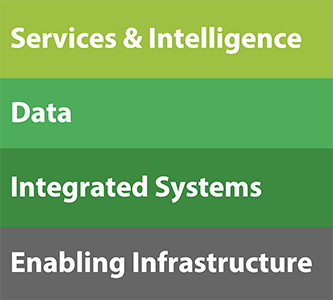It has been almost three years since Covid-19 took over our lives and the commercial real estate industry. Property development continues to surge though markets are becoming saturated, and the financial market conditions and interest rates drive owners to evaluate design and construction decisions. Teams are rapidly adding value engineering to the development process to prioritize investments in building infrastructure, building technologies, and what not to ignore to compete for high-value, long-term tenants.
Owners are also balancing ESG (Environmental, Social, and Governance), sustainability, net-zero, healthy building, hybrid work policy, transportation modalities, and other industry game-changing demands that continue to shift priorities for building design and construction.
What has not changed in the built environment?
The industry is still at a critical inflection point in adopting technology. Like other industries we know such as healthcare and financial, technology has transformed how consumers and employees adopt, use, and digitally interact with organizations. Along with the use of technology, access and use of integrated data have changed history. For example, ten years ago, you could not access your patient healthcare record on your mobile device. Even in the most uncertain economic times, industries do not stop moving the needle on the technology adoption curve. The same holds for the property development and commercial real estate industry.
As developers embark on 2023 value engineering efforts, here are three recommendations to consider that will keep your properties able to support technological innovations in the built environment for at least the next decade.
A scalable, converged network infrastructure is not optional.
In 2018, my team and I discussed smart buildings and technology infrastructure with architects and building owners in major U.S. markets. Many of our building owner meetings centered on modernizing current network infrastructure (opening walls and ceilings) to support emerging smart building technologies powered by Power Over Ethernet (POE) and other point-to-point solutions. How could they use what they have within their current buildings to transform connectivity, improve interior aesthetics, gain better systems control, and enhance security? Owners needed a scalable, converged network infrastructure emphasizing "scalable." Architects were learning to incorporate systems thinking into their design to create technology infrastructures in new buildings that would sustain and grow with an industry poised for disruption. We had many AIA (American Institute of Architects) learning sessions discussing the new 4th utility alongside electric, gas, and water; network access.
Fast forward to 2023 and the post-pandemic state of real estate development. Access to broadband and the internet, or what we like to describe as digital inclusivity, is now hugely important in helping to reduce the digital divide across the nation to support jobs, education, and healthcare. Smart building technologies and the ability to integrate with other building systems continue to advance and will not slow down.
Think again if you consider leaping backward to the early 2000s on building design and forgoing technology infrastructure. Your building will be as obsolete as the 2018 versions. Ensure the scalable, converged network infrastructure is included in your implementation to support future investments in technologies that may need to be on hold for a few months.
Systems Integration Planning Matters
As owners continue to plan for the technologies that will be a part of the converged network, mapping the interconnectedness of these systems is vital. Systems integration planning can help influence value engineering decisions as owners and their teams evaluate the impact technologies, and their integration have on users, experiences, operations, and performance.
When looking at the technology stack that creates a smart building, the infrastructure is the foundation for which the integrated systems reside; the next level is where data is created, stored, and accessed, thus enabling the building systems to provide the most advanced services and intelligence possible. For an owner to create scale in their property - the ability to add technology over the lifecycle of the asset - they need to at minimum prioritize the bottom two layers of this stack: enabling infrastructure and the integration of systems.

Do not ignore 2023 policies for data management.
The implementation, adoption, and effective use of data is what happens when an industry transforms itself through technology. Once you get the technology infrastructure and systems in place, the building owners, managers, and occupants begin to use the technology, it becomes part of workflows and daily living. Building owners use the available data to manage their property and tenants, make informed decisions, reduce costs and energy use, and easily track financial outcomes and report on key performance indicators to their shareholders and community.
If you are delaying the implementation of some building technologies, you will need to implement them in the future. Technologies that land in the "nice-to-have" column of your value reengineering process could be mainstream soon. Consider indoor air quality. Even the least complicated technology requires access to data, and policies need to be in place to manage the data your building is producing now. A data management policy easily sets your organization up to streamline technology implementations today and prepare for future growth.
Are you value engineering a Smart Building design? Consider these three areas – scalable infrastructure, systems integration, and data management before eliminating implementations that will cost a lot more in the future.
Questions? Email Bill Moten, LEDG Smart Buildings Practice Leader, at bam@ledesigngroup.com or connect with him on LinkedIn.